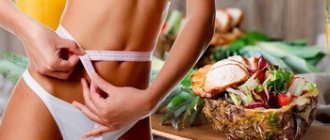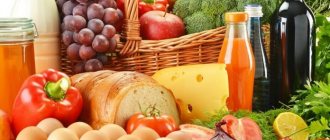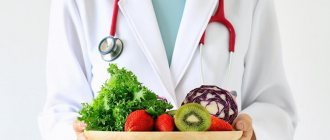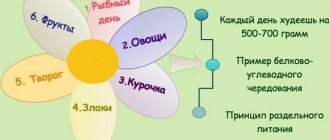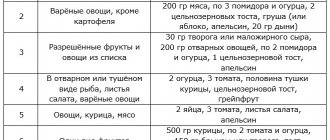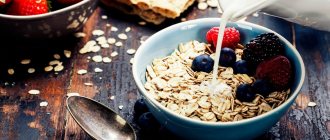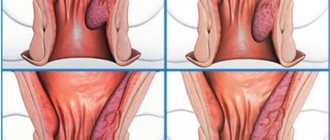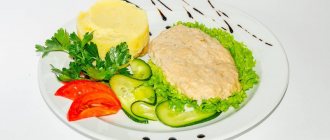Diet No. 2 is prescribed to reduce intestinal motility and improve gastric secretory function. Allowed and prohibited foods, as well as basic recommendations from nutritionists, are given below in this article.
Table No. 2 is a complete nutritional system, which is prescribed by a gastroenterologist and is as integral a part of the treatment process as drug therapy. A proper diet helps eliminate unpleasant symptoms and improve quality of life, as well as avoid relapses.
Chemical composition and energy value of dietary table No. 2
Proteins: 90–100 g (45% animal proteins). Fats: 80–85 g (30% vegetable fats). Carbohydrates: 350 g (no more than 40 g of simple carbohydrates). Daily calorie content: 2,200 – 2,400 kcal. Free liquid: 1.5–2 l. Table salt: 6–8 g. Vitamins: retinol (A) 2 mg, riboflavin (B2) 4 mg, thiamine (B1) 4 mg, nicotinic acid (B3) 30 mg, ascorbic acid (C) 100 mg. Macroelements: calcium 0.8 g, magnesium 0.5 g, phosphorus 1.2 g. Microelements: iron 15 mg. Optimal food temperature: from 15 to 65 degrees Celsius.
general characteristics
The “2 table” diet provides complete nutrition, moderately stimulates the secretory function of the digestive organs and normalizes the motor function of the gastrointestinal tract.
General characteristics:
a physiologically complete diet with moderate mechanical sparing and moderate stimulation of the secretion of the digestive organs. Dishes of varying degrees of grinding and heat treatment are allowed - boiled, stewed, baked, fried without forming a rough crust (without breading in breadcrumbs or flour). Puree dishes are made from foods rich in connective tissue or fiber. Avoid foods and dishes that linger in the stomach for a long time, are difficult to digest, irritate the mucous membrane of the gastrointestinal tract, and very cold and hot dishes.
Chemical composition and calorie content:
- carbohydrates - 400-420 g,
- proteins - 90-100 g (60% animals),
- fats – 90-100 (25% vegetable),
- calories - 2800-3000 kcal,
- sodium chloride - up to 15 g,
- free liquid - 1.5 l.
Diet:
4-5 times a day without large meals.
Recommended products and dishes of diet table No. 2
Bread: made from yesterday's premium wheat flour, cookies, savory buns. Soups: pureed cereal soups and noodle soup in a weak meat or mushroom broth, vegetable soups with finely chopped and boiled vegetables, if tolerated, fresh cabbage soup and borscht are acceptable. Meat dishes: boiled, baked, fried dishes in one piece or in the form of cutlets, prepared from beef, veal, chicken, turkey, rabbit (without skin, cartilage); Boiled tongue is recommended, milk sausages are acceptable. Fish dishes: boiled or baked low-fat fish in pieces or in the form of cutlets. Side dishes: boiled crumbly porridge from cereals (with the exception of pearl barley and millet), vermicelli, boiled, stewed and baked potatoes, beets, carrots, zucchini, cabbage, pumpkin, green peas. Porridge: boiled milk porridge (with the exception of pearl barley and millet). Dairy products: milk, cream (add to drinks), yogurt, acidophilus, kefir, sour cream, cheese and cottage cheese (fresh or in dishes). Eggs: scrambled eggs without crust and soft-boiled eggs. Appetizers: salads of boiled vegetables with meat, tongue, fresh ripe tomatoes, pate, soaked herring, doctor's sausage. Sauces, spices: sour cream sauce, mild sauces with meat broth, cinnamon, vanilla, bay leaf, chopped fresh herbs (dill, celery, parsley). Sweet dishes: jelly, puree from fresh sweet berries and fruits, jelly from fruits and berries, pureed compote, baked apples and pears, honey, marshmallows, marshmallows, meringues, toffee, preserves, non-sour jams. Drinks: tea with milk or lemon, cocoa, coffee with milk, rose hip decoction, juices diluted with water. Fats: unsalted butter, ghee, refined vegetable oil.
Menu for the week: what you can eat
Choose the right food delivered to your home
Diet selection
Only for Moscow residents
Options for a weekly menu for each meal according to the “2 table” diet:
1st breakfast options:
- steam omelette, oatmeal, tea with milk;
- lazy dumplings with sour cream, cocoa;
- oat pancakes with jam, herbal tea;
- pancakes with cottage cheese, tea with milk;
- sandwiches with butter and cheese, cocoa;
- omelette with cheese, tea;
- cheesecakes with sour cream and jam, tea.
Options for 2nd breakfast:
- jelly;
- rosehip decoction with honey;
- apple and orange salad;
- marshmallow, bran decoction;
- baked apple;
- fruit puree;
- ripe orange.
Lunch options:
- meatball soup, chicken soufflé;
- chicken noodle soup, steamed cauliflower;
- mushroom broth soup with boiled rice, steamed cutlets, boiled beet salad;
- buckwheat soup with potatoes in low-fat chicken broth, vermicelli with sour cream sauce;
- low-fat fish broth with potatoes and herbs, meat pudding with vegetables;
- fresh cabbage soup, boiled tongue, tomato juice;
- fish pie, carrot-apple juice with water.
Afternoon snack options:
- fruit puree;
- yogurt;
- cottage cheese with sour cream and fruit puree;
- rosehip decoction with honey;
- jelly.
Dinner options:
- buckwheat, steamed fish, kefir;
- vegetable stew, piece of veal, fermented baked milk;
- pancakes with boiled meat, tomato juice, kefir;
- mashed potatoes, steamed chicken fillet, carrot salad with cheese, yogurt;
- cauliflower puree, steamed veal cutlets, compote;
- buckwheat with stewed meat with carrots, fermented baked milk;
- pancakes with liver pate, cottage cheese with fruit, kefir.
From the above dish options you can create a varied diet for every day.
Excluded foods and dishes of the diet table No. 2
Foods that cause fermentation processes in the gastrointestinal tract and foods that mechanically irritate the stomach should be excluded from the diet. Excluded are fresh bread and products made from butter and puff pastry, okroshka, legume soups, milk soups, fatty meats, pickles, smoked foods, canned food, marinades, seasonings, sauces, carbonated drinks (including kvass). Also exclude sharp cheeses, coarse cereals (millet, corn, barley and pearl barley), hard-boiled eggs, sorrel, onions, cucumbers, tomatoes, legumes, white cabbage, spinach, turnips, radishes, radishes, paprika, garlic, mushrooms, sour fruits and berries. Avoid eating chocolate and rich pastry creams.
Indications
Gentle diet No. 2 is indicated for chronic gastritis and enterocolitis. The program is designed to normalize the secretion of digestive enzymes and has the following goals:
- activation of gastric juice formation;
- supplying the body with proteins, fats, carbohydrates and vitamins;
- regulation of fermentation processes;
- improvement of gastric motility;
- prevention of mechanical and thermal damage to the mucosa;
- normalization of the functioning of the duodenum.
Important! The nutritional system is prescribed exclusively by a specialist, based on the results of clinical and instrumental studies. The patient should be under constant supervision of a doctor, who will adjust the diet if the condition worsens. In addition, table No. 2 has its contraindications and is not suitable for certain concomitant diseases of the liver, pancreas and gall bladder.
Dietary table recipes No. 2:
- pureed rice soup
- fresh cabbage soup
- borsch
- cutlets without breading
- baked meat
- fish cutlets
- crumbly buckwheat porridge
- vegetable stew
- sour cream sauce
- soft-boiled egg
- rosehip decoction
- fruit mousse
- mashed potatoes
- steam omelette
- baked apple with sugar
- apple jelly
- Steam curd soufflé
- fruit jelly
- rice pudding
- fruit sauce
- salad of boiled vegetables and boiled sausage
- berry mousse
- baked pear with sugar
- boiled pike perch
- meat soufflé
- fish aspic
Photos used in this material belong to shutterstock.com
Indications for use.
Therapeutic diet No. 2 according to Pevzner is recommended for chronic gastritis with secretory insufficiency, when the exacerbation of the disease is mild, as well as during the recovery period after an exacerbation. Also indicated are enteritis, colitis at the recovery stage, when a transition to good nutrition is required, and for chronic colitis and enteritis without exacerbation, if there are no other concomitant diseases of the liver, biliary tract, pancreas, gastritis with increased secretion. During the recovery period after operations and acute infectious diseases.
Nutritional features.
Therapeutic diet No. 2 is moderately gentle on the digestive system . The dishes of this table are chopped and cooked to varying degrees. They can be boiled, stewed, baked and even fried, but without a rough crust, that is, breading in breadcrumbs or flour is excluded. The diet also includes pureed dishes. For their preparation, products rich in fiber are used. Difficult to digest foods that linger in the stomach for a long time and irritate its mucous membrane are unacceptable. Spicy seasonings and very hot or very cold foods are strictly excluded from the diet. The optimal diet is four to five times a day without large meals. This therapeutic nutrition allows you to moderately stimulate the functioning of the digestive organs, normalizes the motor activity of the gastrointestinal tract.
Chemical composition and energy value.
Proteins – 90-100 g (60% animal), fats – 90-100 g (25% vegetable), carbohydrates – 400-420 g, table salt – up to 15 g, free liquid – 1.5 l.
The calorie content of the diet is 2800-3000 kcal. Product table
| Authorized Products | Prohibited Products |
| Bread products | |
| White and gray wheat bread baked yesterday, unsweetened varieties of bakery products, cookies, dry biscuits. | Fresh bread and flour products from butter and puff pastry. |
| Milk and dairy products | |
| Whole, powdered and condensed milk is allowed with tea and other drinks, as well as in various dishes, cottage cheese, cheesecakes, yogurt, kefir, mild grated cheese. | |
| Soups | |
| Soups made from weak low-fat meat, fish, mushroom broth and vegetable broth with finely chopped or pureed vegetables, pureed cereals, borscht, beetroot soup, cabbage soup made from fresh finely shredded cabbage. | Dairy, bean, pea soups, millet soup, okroshka. |
| Meat and meat dishes | |
| Lean varieties of meat, lean beef, pork, veal, lamb, poultry are prepared preferably steamed or boiled, possibly baked, less often fried (can be brushed with egg, but not breaded) in the form of cutlets and meatballs, less often in pieces. Boiled tongue and liver are also allowed. | Fatty and stringy varieties of meat and poultry, except dietary (duck, goose). You can eat lamb and pork in limited quantities. All canned and smoked meats are strictly prohibited. |
| Fish and fish dishes | |
| Low-fat varieties of fish, cooked in pieces or in the form of cutlets. The fish can be boiled in water or steamed, or fried without breading. | Fatty fish, salted, smoked fish, canned fish. |
| Cereals and pasta | |
| Mashed semi-viscous porridges, baked puddings. Pasta should be small and only boiled. Porridges are prepared with water or with the addition of milk. | Corn grits, pearl barley, barley, and millet in limited quantities. |
| Vegetables | |
| Potatoes, carrots, zucchini, pumpkin, beets, cauliflower are prepared in the form of various vegetable purees, cutlets (boiled or stewed), and vegetable casseroles. Depending on the tolerance of each individual, you can include white cabbage, ripe tomatoes, and green peas in your diet. It is allowed to flavor dishes with finely chopped herbs. | Raw, ungrated vegetables, pickled and salted, onions, radishes, radishes, bell peppers, cucumbers, rutabaga, garlic, mushrooms. |
| Eggs and egg dishes | |
| Soft-boiled eggs, as well as scrambled eggs without crust or steamed. | Hard-boiled eggs. |
| Fats | |
| Butter and ghee, refined vegetable oil, olive oil. | Pork lard, beef, lamb and cooking fats. |
| Snacks | |
| Soaked herring, jellied fish, meat and tongue, salads from fresh tomatoes, boiled vegetables with meat, fish, eggs. Sausage is also allowed - dietary, doctor's and milk, low-fat ham and jelly, liver pate, vegetable caviar and sturgeon caviar. | Spicy and fatty snacks, smoked meats. |
| Berries and fruits | |
| Berries and fruits in the form of mashed compotes, purees, jelly, jellies, mousses, jams. If tolerated, you can eat tangerines, oranges, watermelon, and grapes without skin. | Rough varieties of fruits and berries in raw form, berries with rough grains (raspberries, red currants) or rough skin (gooseberries, dates, figs). |
| Sweets | |
| Sugar, honey, sweets, and jam are allowed. | Chocolate, chocolate and cream products, ice cream. |
| Beverages | |
| Tea with milk, cocoa, coffee with water and milk or cream, vegetable and berry juices diluted with water, rose hip decoction. | Grape juice and kvass. |
Advantages and disadvantages
| pros | Minuses |
|
|
Reviews and results
Medical nutrition does not mean monotony and tastelessness of dishes. You can diversify it with new dishes - just don’t be lazy and do everything to restore your health. Reviews from patients indicate that this diet has a beneficial effect on the gastrointestinal tract. Already in the first week, pain and discomfort in the stomach decrease, belching and heartburn disappear.
- “... For gastritis, table number 2 is prescribed, the diet completely suits me! There is a point in therapeutic nutrition, and I tested this on myself, since if it is violated, discomfort in the stomach, belching and even diarrhea immediately appear. It’s especially hard after holidays and heavy food”;
- “... I like it, I eat this way almost all the time, at least I try. I got rid of the unpleasant heaviness in the stomach, the bloating disappeared. I started cooking for myself separately, and then the whole family joined. The son said that now he has no stomach discomfort or belching”;
- “... In the spring, when gastritis worsens, you have to seriously take care of your diet. I love spicy foods, so it’s hard for me to tolerate food restrictions, but I have to. I can withstand a maximum of 3 weeks, but even during this time I feel a significant improvement. If it weren’t for my passion for spicy and smoked foods, I think I wouldn’t have suffered from gastritis”;
- “... It’s hard for me to bear it, and it’s even harder to cook for myself separately - I don’t have time. I think it is suitable for retirees or housewives - they have time to cook. Therefore, I can withstand it for 2 weeks, and then retreats begin and the transition to a common table begins. In winter, when there are few berries and fruits, it is especially difficult to organize snacks for yourself - you can only bake apples and carry jars with you to work. Inconvenient."
Diet table number 2 – recipes
Tomatoes with green salad.
Ingredients: 10 g olive oil, 20 g green salad, 100 g tomatoes. Finely chop the peeled tomatoes. Wash the green lettuce thoroughly, chop it finely and mix with the tomatoes. Place in a salad bowl and season with olive oil.
Cucumbers with dill and sour cream.
Ingredients: 20 g sour cream, 10 g dill, 100 g cucumbers. Peel fresh cucumbers, chop them finely and mix with pre-prepared dill. After adding a small amount of salt, season with sour cream.
Rice porridge with raisins and dried apricots.
Ingredients: 5 g butter, 20 g raisins, 20 g dried apricots, 60 ml water, 100 ml milk, 50 g rice. Wash the raisins, dried apricots and rice, pour into boiling water, add sugar and salt, cook for ten minutes. Then add milk and cook over low heat until done. Serve with butter.
Lapshevnik baked with cheese.
Ingredients: 5 g sour cream, 20 g mild cheese, 1-4 eggs, 5 g granulated sugar, 5 g butter, 350 ml water, 60 g noodles. Pour the noodles into salted boiling water, cook, place in a colander, and let the water drain. After this, add grated cheese, egg, sugar, butter, mix well and place on a baking sheet greased with vegetable oil. Spread sour cream on top and bake in the oven.
Author of the article:
Kuzmina Vera Valerievna |
Endocrinologist, nutritionist Education: Diploma of the Russian State Medical University named after. N.I. Pirogov, specialty “General Medicine” (2004). Residency at the Moscow State Medical and Dental University, diploma in Endocrinology (2006). Our authors
Nutritional Features
To obtain the necessary therapeutic effect, it is important to adhere to several features of a balanced diet:
- It is recommended to eat in small portions at least 5 times a day.
- It is advisable to take the last meal no later than 2 hours before the expected bedtime (according to the latest data, the recommended period of time between dinner and bedtime should be 3-4 hours).
- Diet 2 is relatively expanded; recommendations allow the use of fried and baked foods, but in limited quantities. It is optimal to boil or steam food.
- The temperature of the dishes should vary between 15-45 ° C, which makes it possible to provide a gentle regime for the mucous membrane of the stomach and duodenum.
- The choice of optimal food products and the regimen for their intake should be made by the attending physician on an individual basis for each patient, which depends on the nature and severity of the pathological process.
- Before eating, it is advisable to grind it or chew it well before swallowing.
